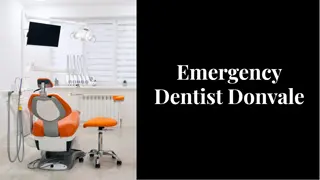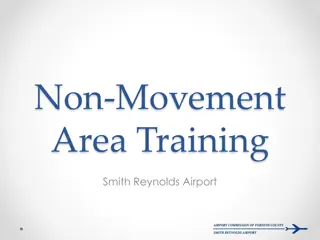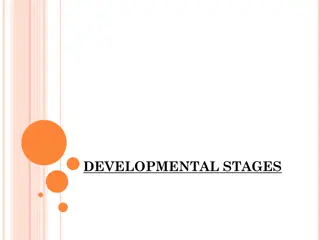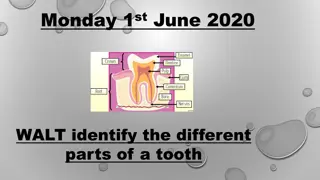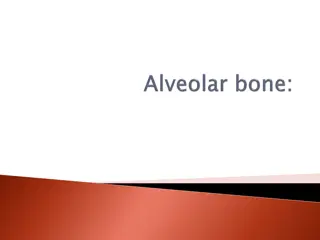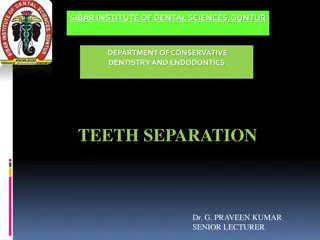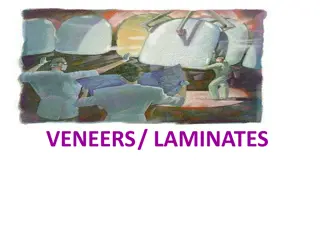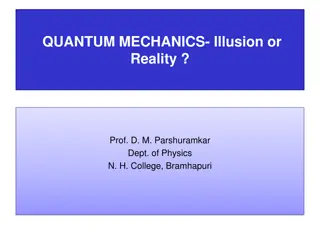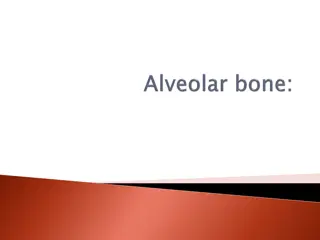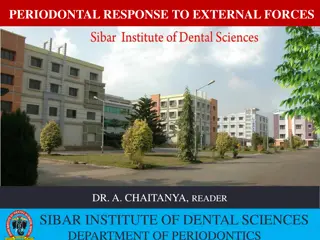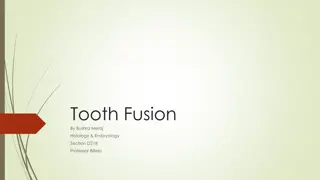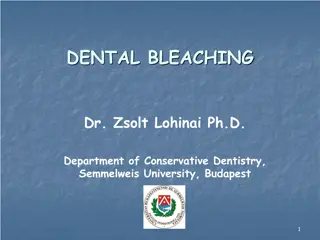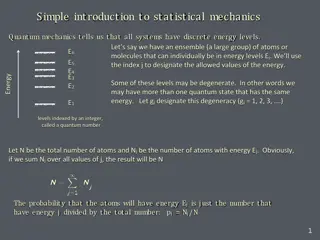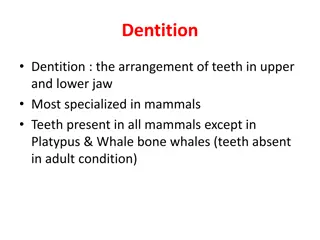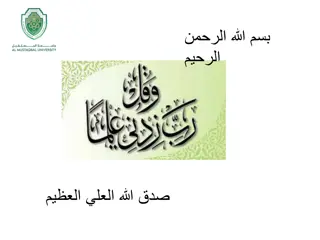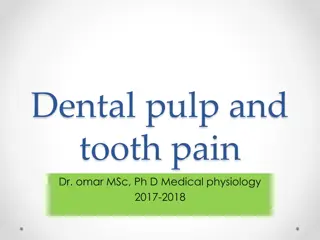
Mechanics of Tooth Movement in Orthodontics
Explore the mechanics of tooth movement in orthodontics, including force vectors, types of force, and the effects of forces on teeth. Learn how proper application of mechanics can enhance treatment efficiency and reduce time.
Download Presentation

Please find below an Image/Link to download the presentation.
The content on the website is provided AS IS for your information and personal use only. It may not be sold, licensed, or shared on other websites without obtaining consent from the author. If you encounter any issues during the download, it is possible that the publisher has removed the file from their server.
You are allowed to download the files provided on this website for personal or commercial use, subject to the condition that they are used lawfully. All files are the property of their respective owners.
The content on the website is provided AS IS for your information and personal use only. It may not be sold, licensed, or shared on other websites without obtaining consent from the author.
E N D
Presentation Transcript
RUNGTA COLLEGE OF DENTAL SCIENCES & RESEARCH TITLE OF THE TOPIC- MECHANICS OF TOOTH MOVEMENT DEPARTMENT OF ORTHODONTICS AND DENTOFACIAL ORTHOPAEDICS
Specific learning Objectives CORE AREAS DOMAIN CATEGORY FORCE AS VECTORS PSYCHOMOTOR MUST KNOW FORCE AND MOVEMENT TYPES OF TOOTH MOVEMENT TYPES OF FORCE PSYCHOMOTOR NICE TO KNOW COGNITIVE MUST KNOW COGNITIVE NICE TO KNOW
CONTENTS PART 1 INTRODUCTION FORCE AS VECTORS FORCE AND MOVEMENTS CENTRE OF RESISTANCE CENTRE OF ROTATION MOMENT PART II TYPES OF TOOTH MOVEMENT TRANSLATION TIPPING COUPLE TYPES OF FORCE INTERMITTENT INTERUPTED CONTINUOUS
INTRODUCTION Mechanics is the study of the effect of forces on a body. Theories of mechanics has potential applications in 3 areas: Precise application of force Understanding of clinical and histological response to various magnitude of force Improving the design of orthodontic appliances. Proper application of mechanics to orthodontic treatment helps in: Increasing the treatment efficiency Reduce the treatment time
FORCE AS VECTORS Force can be defined as an act upon a body that changes or tends to change the state of rest or of motion of that body. In clinical terms it is either push or pull Force = mass * acceleration F= (ma) Forces can be represented using vectors. They have specific magnitude and direction.
FORCE AS VECTORS To understand how a body reacts to more than one force requires the creation of a vector diagram. Sometimes a single force may be resolved into components to simplify or study its effect on a particular body.
FORCE AS VECTORS In the simplest scenario, with the point of application of say two forces being at a common point, The resultant is indicated by the diagonal of the parallelogram drawn using the vectors of the two forces
FORCE AS VECTORS Single force can be resolved by splitting the force vectors into two components at right angles to each other, into a vertical and horizontal component
FORCE AND MOVEMENTS CENTRE OF RESISTANCE Every unrestrained body has a point at which it can (at least in theory) be perfectly balanced. This point is called the center of gravity. When we talk about teeth, we are talking of a body which is restrained by adjacent structures like the periodontal ligament etc. for such restrained bodies the analogous point to the center of gravity is called the center of resistance.
FORCE AND MOVEMENTS CENTRE OF RESISTANCE By definition, as the point in the object at which the resistance to movement is at the maximum. If a force is applied to the center of resistance, the whole body moves equally in the direction of force applied (translation).
FORCE AND MOVEMENTS CENTRE OF RESISTANCE
FORCE AND MOVEMENTS CENTRE OF RESISTANCE
FORCE AND MOVEMENTS CENTRE OF RESISTANCE Center of resistance varies with: Root length. Alveolar bone height. The root morphology- single or multirooted teeth
FORCE AND MOVEMENTS CENTRE OF RESISTANCE The center of resistance sometimes changes with root resorption or loss of alveolar support because of periodontal disease For example, in the case of loss of alveolar support, this point moves apically
FORCE AND MOVEMENTS CENTRE OF ROTATION The center of rotation is any point around which rotations occur when the tooth is being moved. When a body rotates, there is a point located either internal or external to the body around which the body turns.
FORCE AND MOVEMENTS CENTRE OF ROTATION This point is termed the center of rotation. The location of this point is dependent on the force system applied to the tooth The center of rotation is located at variable points depending on how far the force is applied from the center of resistance.
FORCE AND MOVEMENTS CENTRE OF ROTATION The center of rotation can approach, but it can never reach the center of resistance. If the force is applied at the center of resistance, the body translates and the center of rotation is at infinity
FORCE AND MOVEMENTS CENTRE OF ROTATION
FORCE AND MOVEMENTS MOMENT OF FORCE When the line of action of an applied force does not pass through the center of resistance the force will produce some rotation. The potential for rotation is measured as a moment.
FORCE AND MOVEMENTS MOMENT OF FORCE A moment may be determined by multiplying the magnitude of the force (F) by the perpendicular distance (d) from the center of resistance to the line of action of this force: M = F * d. where, M is the moment, F, the magnitude of force, and d, the perpendicular distance of the point of application from the center of resistance
FORCE AND MOVEMENTS MOMENT OF FORCE The moment is measured in units such as gram millimeters. Hence, the moment of force can be altered by changing the magnitude of the force or by changing the perpendicular distance of the line of action of the force to the center of resistance. Hence, if the magnitude of the moment needs to be decreased, the force can be applied closer to the center of resistance of the tooth
TYPES OF TOOTH MOVEMENTS Tooth movement can be described in many ways. The basic types of tooth movement are: 1. Tipping 2. Translation 3. Root movement 4. Rotation
TYPES OF TOOTH MOVEMENTS Tipping Tipping is the simplest tooth movement and the one easily carried out. In tipping, there is greater movement of the crown than that of the root. There are two types of tipping: Uncontrolled tipping and Controlled tipping
TYPES OF TOOTH MOVEMENTS Uncontrolled Tipping Uncontrolled tipping is produced when a single force is applied to the crown of a tooth. The crown moves in one direction and the root moves in the opposite direction. Uncontrolled tipping is useful when incisors have to be proclined
TYPES OF TOOTH MOVEMENTS Features of Uncontrolled Tipping Center of rotation: It is in between the center of resistance and apex of the root Force required: 35 60 g Moment to force ratio: 0:1 to 5:1
TYPES OF TOOTH MOVEMENTS Features of Uncontrolled Tipping Loading pattern: The periodontal ligament (PDL) is stressed near the apex on the same side as the applied force and at the crest of the alveolar bone on the opposite side
TYPES OF TOOTH MOVEMENTS Controlled Tipping This is a desirable tooth movement when compared to uncontrolled tipping. The crown moves in one direction and there is minimal or no movement of the root in the opposite direction. Controlled tipping is useful in retraction of excessively proclined incisors when roots are normally positioned
TYPES OF TOOTH MOVEMENTS Features of Controlled Tipping Center of rotation is at the root apex Force required: 35 60 g Moment to force ratio = 7:1
TYPES OF TOOTH MOVEMENTS Features of Controlled Tipping Loading pattern: There is minimum stress of the PDL at root apex. This prevents root movement.


